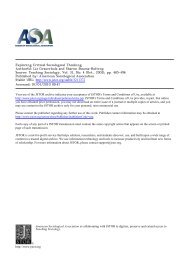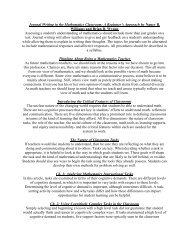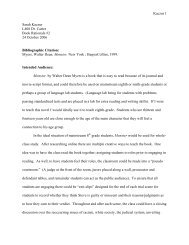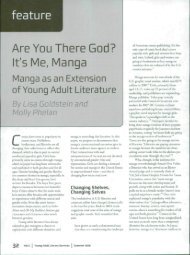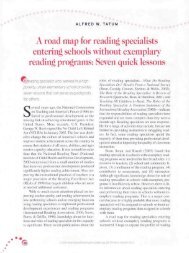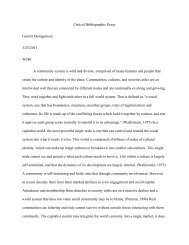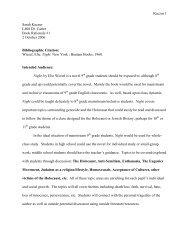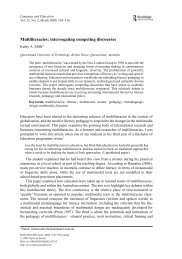Dyson 2003 Welcome to the Jam.pdf - Oncourse
Dyson 2003 Welcome to the Jam.pdf - Oncourse
Dyson 2003 Welcome to the Jam.pdf - Oncourse
You also want an ePaper? Increase the reach of your titles
YUMPU automatically turns print PDFs into web optimized ePapers that Google loves.
“<strong>Welcome</strong> <strong>to</strong> <strong>the</strong> <strong>Jam</strong>”<br />
anne haas dyson<br />
ceived as “cheap” consumer goods (like television shows) and more “high<br />
ticket items such as computers, CD-ROMs, educational materials, and books”<br />
(p. 88). Teachers at day-care centers serving lower income children also value<br />
such goods but may be more <strong>to</strong>lerant of, and more forthcoming about, <strong>the</strong>ir<br />
own popular pleasures, in part because <strong>the</strong> media seem a much less ominous<br />
fac<strong>to</strong>r in children’s lives than, for example, poverty or parental absence.<br />
In Rita’s classroom, media use in official school contexts was much more<br />
pervasive among children from <strong>the</strong> bro<strong>the</strong>rs and sisters’ neighborhood than it<br />
was among those from <strong>the</strong> more affluent neighborhood. Moreover, certain<br />
media sources (like <strong>the</strong> movie Space <strong>Jam</strong>) were uniformly and almost exclusively<br />
referenced by African American children. In this extensive use of <strong>the</strong><br />
media and in <strong>the</strong> relationship between media use and identity, Rita’s young<br />
students were similar <strong>to</strong> participants in my previous research in local schools<br />
(<strong>Dyson</strong>, 1997) and reflective of a national survey of children’s media use<br />
(Rideout, Foehr, Roberts, & Brodie, 1999). That survey documented <strong>the</strong> pervasiveness<br />
of media use among American children from age two <strong>to</strong> eighteen<br />
and, even more so, among low-income and African American and Latino children.<br />
However, a permeability <strong>to</strong> children’s textual resources has not been a dominant<br />
quality of school literacy curricula. Indeed, dominant curricula tend <strong>to</strong><br />
have an antagonistic or, at <strong>the</strong> very least, a compensa<strong>to</strong>ry relationship <strong>to</strong> childhoods<br />
deemed not “mainstream” (i.e., viewed as not print centered). This relationship<br />
was evident in <strong>the</strong> beginnings of intensive political and academic attention<br />
<strong>to</strong> very young children’s literacy in <strong>the</strong> turbulent 1960s (e.g., Bereiter<br />
& Englemann, 1966) and it has continued up <strong>to</strong> <strong>the</strong> present (e.g., Neuman,<br />
2001).<br />
One effect of <strong>the</strong> continual return <strong>to</strong> narrow conceptions of young children’s<br />
literacy is <strong>the</strong> continual neglect of popular literacies (Luke & Luke,<br />
2001) and of <strong>the</strong> textual manipulation processes through which media material<br />
is adapted <strong>to</strong> local desires and needs. As I have argued, <strong>the</strong>se very processes<br />
are key <strong>to</strong> written language development and, moreover, <strong>to</strong> children’s<br />
play with identity, with who <strong>the</strong>y are as people of particular heritages and loyalties.<br />
Opening up classrooms <strong>to</strong> children’s textual resources and literate processes<br />
means opening <strong>the</strong>m up as well <strong>to</strong> <strong>the</strong> pleasures and challenges of children’s<br />
everyday lives and <strong>to</strong> <strong>the</strong> multimedia of <strong>the</strong> emerging and everchanging<br />
textual scene (Hull & Schultz, 2001). In o<strong>the</strong>r words, it means educa<strong>to</strong>rs,<br />
and schools as institutions, situating <strong>the</strong>mselves in this time of energetic<br />
and spirited engagement with texts of a range of symbolic and social<br />
types and, in this way, joining <strong>the</strong> children in <strong>the</strong> jam — <strong>the</strong> literacy jam.<br />
Notes<br />
1. “<strong>Welcome</strong> <strong>to</strong> <strong>the</strong> <strong>Jam</strong>” (Quad City DJs, 1996) is part of <strong>the</strong> hip-hop and R&B score for<br />
<strong>the</strong> film Space <strong>Jam</strong> (Falk, Ross, & Pytka, 1996). The film stars Michael Jordan, a well-<br />
357



